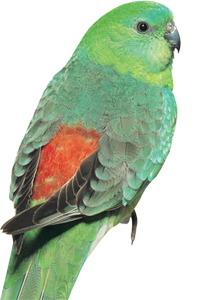Profiles
RED-RUMPED PARROT
(Psephotushaematonotus)
Family: Parrot
Origin: Southeast Australia and common in sparsely timbered grasslands, open plains and cultivated lands.
Size: 270mm including 130mm tail
Description:
The male has a forehead and cheeks that are blue-green with the rest of the head and neck bright green. Its back is a dull blue-green, the rump is dull red, the breast is bright green, the belly is yellow and the vent and under tail coverts are white with tinges of green.
Its shoulders are yellow while the under wing coverts, bend of wing and the flight feathers are blue. The upper tail coverts are green with the central tail feathers being a green-blue while the outer feathers are blue-green edged with white. Its eyes are brown, beak is black and the legs are grey.
The female’s crown, nape, back and wings are bright olive-green, the neck and breast are a dull olive-yellow and the belly, vent and under tail coverts are white. She sports a pale blue patch on her shoulder and her rump and upper tail coverts are green. Its beak is grey. The immature chicks look similar to the adult birds but their colouring is slightly duller.
Care:
In the wild these birds nest in hollow limbs or a hole in either a living or dead tree. If placing these birds in an aviary put hollow limbs or rotting logs, planted with grasses and scrub, that resembles their native habitat and you will raise some very happy Red-RumpedParrots.
And as with all birds maintaining strict hygiene and cleanliness of all food and drinking water and bathing dishes is most important – birds have very sensitive systems and can get ill quite quickly.
In the wild, these birds spend much of their day on the ground scratching and searching for grass seeds, certain varieties of edible leaves and the flowers of some thistles.
Eats:
In the domestic situation, they eat good quality small parrot mix, fresh fruit and greens, (no avocado as these can be poisonous to many birds), and to aid their digestion a good supply of cuttlefish bone, grit and unwashed charcoal, and for an occasional treat you can feed each bird a biscuit.
Features:
The breeding season is from August to December and the female lays four eggs and incubates them for 20 days, and guards them fiercely. Once the chicks have hatched, the male will feed them almost hourly.
Call:
A shrill two syllable whistle interspersed with a warbling song. And has a soft chatter if looking after a nest site.
Personality:
As with most birds they are highly strung and these are no exception. No matter if you are keeping these birds in a cage or an aviary you will need to ensure that they an area they can “escape” to if they see hawks, or other predatory birds flying overhead or snakes. They can injure themselves if startled in a small cage or aviary.
